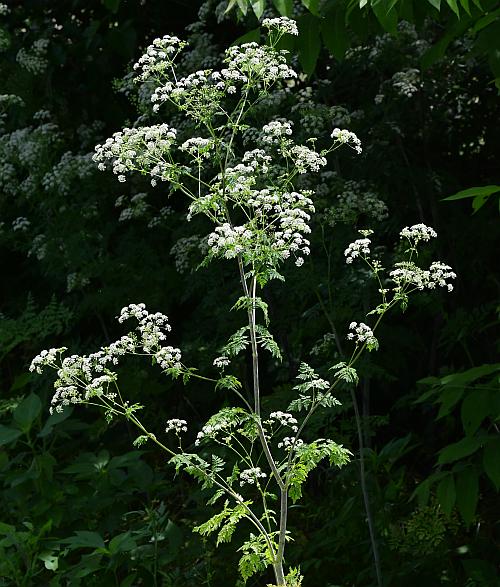Conium maculatum L.
Poison Hemlock

Introduced
CC = *
CW = -3
MOC = 51
© SRTurner
Conium maculatum L.Poison Hemlock | |
 |
Introduced CC = * CW = -3 MOC = 51 |
© SRTurner |
|
Family - Apiaceae Habit - Coarse biennial forb, from large taproot. Stems - Erect, to 3 m, green with spots or mottling, glabrous, usually strongly glaucous.
Leaves - Alternate and basal, with 1 to several basal leaves usually present at flowering, pinnately compound, glabrous. Basal and lower stem leaves long-petiolate, the median and upper leaves short-petiolate to nearly sessile, at least the lowermost sheathing bases somewhat inflated. Leaf blades 3-40 cm long, broadly ovate to ovate-triangular, those of the basal and lowermost stem leaves 3 or 4 times pinnately compound, the ultimate leaflets 5-35 mm long, oblong-lanceolate to ovate, narrowed at the base, pinnately lobed, the lobes narrowed or tapered to a blunt or sharp point at the tip; those of the median and upper leaves progressively reduced, 2 or 3 times pinnately compound, the leaflets similar to those of the lower leaves.
Inflorescence - Compound umbels at branch tips, many per plant, mostly long-stalked. Involucre of 4-8 bracts, these 2-6 mm long, much shorter than the rays, spreading to reflexed at flowering, narrowly lanceolate to narrowly ovate, with broad, thin, papery margins and sharply pointed tips, some adjacent bracts sometimes fused toward the base. Rays numerous, 1.5-3.0 cm long, glabrous. Involucel of 4-9 bractlets, these shorter than the flower stalks, similar to the bracts but smaller. Florets typically about 15 per umbellet, the stalks 3-6 mm long.
Flowers - Sepals absent. Petals 5, white, obovate, typically one larger than the others, glabrous, to 1.2 mm long, 1 mm broad, rounded or appearing notched at the tip, apiculate with the apiculus adaxially recurved. Margins of petal folding slightly downward. Stamens 5, alternating with petals. Filaments to 1 mm long, white, glabrous. Anthers pale yellow to whitish, 0.15 mm broad. Stylopodium present, slightly flattened, greenish. Ovaries glabrous.
Fruits - Schizocarps 2.5-3.5 mm long, ovate to broadly elliptic-ovate in outline, flattened laterally, glabrous, dark brown with pale ribs, the mericarps often slightly narrowed along the commissures, with 5 ribs, these blunt and somewhat corky.
Flowering - May - August. Habitat - Waste groung, disturbed sites, pastures, open fields, low ground, railroads, roadsides. Origin - Native to Eurasia. Lookalikes - Several other members of the Apiaceae, especially Cicuta maculata, but also including Angelica venenosa, Daucus carota, and others. Other info. - This large plant is scattered to common across most of Missouri, and can form dense stands in some places. It is also found across most of the continental U.S. It is relatively easily recognized, with multiple white inflorescences and large, lacy-divided leaves. Overwintering plants form lush growths of ferny, deep green rosettes in the late winter and early spring.
Photographs taken at the Kansas City Zoo, 5-22-00, and in Eminence, MO., 6-6-03 (DETenaglia); also along the Katy Trail near Marthasville, Warren County, MO, 5-20-2007, 5-26-2012 and 6-05-2022, along the Katy Trail near Dutzow, Warren County, MO, 4-12-2012 and 5-22-2020, along the Katy Trail near Augusta, St. Charles County, MO, 4-28-2012 and 6-06-2015, and along the Katy Trail near Treloar, Warren County, MO, 7-04-2020 (SRTurner). Image of The Death of Socrates (Jacques-Louis David, 1787) public domain, courtesy of Wikipedia. |